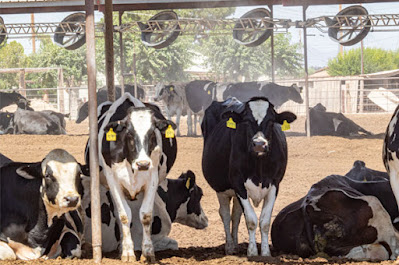Effects of heat stress on dairy cows?
Heat stress can decrease feed consumption, lower milk production in cows and alter composition. It can also have a negative impact on reproduction rates. Cows exhibit heat stress in many ways, and the impact can be seen in both the short- and long-term. Understanding this issue and how to combat it is critical for producers managing herds in warm, humid climates or those in areas where extreme heat occurs during the summer months.
 |
| How does heat stress impact dairy cows? |
Signs of heat stress in dairy cows
- Increased respiration (open-mouthed panting)
- Decreased activity
- Agitation
- Excessive salivation
- Reduced feed intake
- Increased water consumption
- Less rumination
- Lower milk yields
- Acidosis
Preventing heat stress in dairy cows
- Provide shade. Cows experience lower respiration rates, decreased body temperatures and less aggression when provided with adequate shade.
- Clean water tanks regularly. Cows can drink 20–30 gallons of water on a normal day, but they may drink as much as 50% more when the temperature and humidity indexes rise. Providing fresh, clean water will encourage cows to drink more and stay hydrated.
- Feed during cooler hours. Cows don’t like to consume hot feed, and TMRs are prone to heating when left out. By unloading, mixing and feeding in the morning, cows can eat before the feed gets hot and ruminate during the warmer hours of the day.
- Watch for manure inconsistencies. Decreased rumen fermentation efficiency occurs when the cow is experiencing heat stress, leading to lost nutrient utilization. Reformulating the ration can help to achieve optimal nutrition potential during periods of decreased dry matter intake.
- Ensure access to feed. Depressed intake is commonly related to heat stress. By providing continuous access to feed, cows will eat small amounts throughout the day, which will help to reduce the thermal heating that would otherwise be produced by consuming large meals.
- Use sprinklers, soakers and fans. Observe where the cows are congregating. Why are they there? Is a sprinkler out elsewhere in the barn? Are the fans providing air flow? Even if you have cooling equipment, ensure that it is optimally located and is functioning properly.
- Reduce time spent in holding pens. A key issue with heat stress is that the environment is too warm to dissipate the heat coming from the cows. Keeping cows in close holding pens for prolonged periods of time reduces space and airflow.
- Don’t lock up during midday. Cows are smart and will move away from areas that are too hot, but only if they have the space to do so. By allowing them freedom to move during the hottest time of the day, they can move to cooler locations in the barn.
- Feed more digestible, high-quality forages. Since cows are prone to eating less when hot, providing efficient access to nutrients is essential to health and production. First-cutting or fermented forages provide energy without requiring as much rumination as more fibrous feeds, thereby reducing provisional heating.
- Utilize a yeast culture additive. Yeast cultures have been found to stimulate the bacteria in the rumen responsible for both fiber digestion and acid removal. This will aid in improved fermentation efficiency and prevent acidosis, which can decrease body temperature.
Tags:
Dairy Farming
